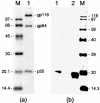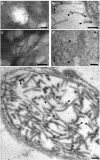The gene encoding the nucleocapsid protein of Gill-associated nidovirus of Penaeus monodon prawns is located upstream of the glycoprotein gene
- PMID: 15280504
- PMCID: PMC479087
- DOI: 10.1128/JVI.78.16.8935-8941.2004
The gene encoding the nucleocapsid protein of Gill-associated nidovirus of Penaeus monodon prawns is located upstream of the glycoprotein gene
Abstract
The ORF2 gene of Gill-associated virus (GAV) of Penaeus monodon prawns resides 93 nucleotides downstream of the ORF1a-ORF1b gene and encodes a 144-amino-acid hydrophilic polypeptide (15,998 Da; pI, 9.75) containing 20 basic (14%) and 13 acidic (9%) residues and 19 prolines (13%). Antiserum to a synthetic ORF2 peptide or an Escherichia coli-expressed glutathione S-transferase-ORF2 fusion protein detected a 20-kDa protein in infected lymphoid organ and gill tissues in Western blots. The GAV ORF2 fusion protein antiserum also cross-reacted with the p20 nucleoprotein in virions of the closely related Yellow head virus. By immuno-gold electron microscopy, it was observed that the ORF2 peptide antibody localized to tubular GAV nucleocapsids, often at the ends or at lateral cross sections. As GAV appears to contain only two structural protein genes (ORF2 and ORF3), these data indicate that GAV differs from vertebrate nidoviruses in that the gene encoding the nucleocapsid protein is located upstream of the gene encoding the virion glycoproteins.
Figures





Similar articles
-
Gill-associated virus of Penaeus monodon prawns: an invertebrate virus with ORF1a and ORF1b genes related to arteri- and coronaviruses.J Gen Virol. 2000 Jun;81(Pt 6):1473-84. doi: 10.1099/0022-1317-81-6-1473. J Gen Virol. 2000. PMID: 10811931
-
The complete genome sequence of gill-associated virus of Penaeus monodon prawns indicates a gene organisation unique among nidoviruses.Arch Virol. 2002 Oct;147(10):1977-87. doi: 10.1007/s00705-002-0847-x. Arch Virol. 2002. PMID: 12376758 Free PMC article.
-
Vertical transmission of gill-associated virus (GAV) in the black tiger prawn Penaeus monodon.Dis Aquat Organ. 2002 Jul 8;50(2):95-104. doi: 10.3354/dao050095. Dis Aquat Organ. 2002. PMID: 12180710
-
Gill-associated virus of Penaeus monodon prawns. Molecular evidence for the first invertebrate nidovirus.Adv Exp Med Biol. 2001;494:43-8. Adv Exp Med Biol. 2001. PMID: 11774504 Review. No abstract available.
-
Yellow head-like viruses affecting the penaeid aquaculture industry: a review.Aquac Res. 2007 Jun;38(9):893-908. doi: 10.1111/j.1365-2109.2007.01735.x. Epub 2007 Jun 5. Aquac Res. 2007. PMID: 32313427 Free PMC article. Review.
Cited by
-
Complete Genome Sequences of Four Major Viruses Infecting Marine Shrimp in Egypt.Microbiol Resour Announc. 2018 Sep 6;7(9):e00809-18. doi: 10.1128/MRA.00809-18. eCollection 2018 Sep. Microbiol Resour Announc. 2018. Retraction in: Microbiol Resour Announc. 2019 Oct 31;8(44):e01266-19. doi: 10.1128/MRA.01266-19. PMID: 30533940 Free PMC article. Retracted.
-
A Novel RNA Virus, Macrobrachium rosenbergii Golda Virus (MrGV), Linked to Mass Mortalities of the Larval Giant Freshwater Prawn in Bangladesh.Viruses. 2020 Oct 2;12(10):1120. doi: 10.3390/v12101120. Viruses. 2020. PMID: 33023199 Free PMC article.
-
Evidence for a novel coding sequence overlapping the 5'-terminal approximately 90 codons of the gill-associated and yellow head okavirus envelope glycoprotein gene.Virol J. 2009 Dec 17;6:222. doi: 10.1186/1743-422X-6-222. Virol J. 2009. PMID: 20017924 Free PMC article.
-
Characterization of Dak Nong virus, an insect nidovirus isolated from Culex mosquitoes in Vietnam.Arch Virol. 2013 Nov;158(11):2273-84. doi: 10.1007/s00705-013-1741-4. Epub 2013 Jun 2. Arch Virol. 2013. PMID: 23728735 Free PMC article.
-
RNA transcription analysis and completion of the genome sequence of yellow head nidovirus.Virus Res. 2008 Sep;136(1-2):157-65. doi: 10.1016/j.virusres.2008.05.008. Epub 2008 Jun 11. Virus Res. 2008. PMID: 18582978 Free PMC article.
References
-
- Boonyaratpalin, S., K. Supamattaya, J. Kasornchandra, S. Direkbusaracom, U. Aekpanithanpong, and C. Chantanachookin. 1993. Non-occluded baculo-like virus, the causative agent of yellow-head disease in the black tiger shrimp (Penaeus monodon). Fish Pathol. 28:103-109.
-
- Chantanachookin, C., S. Boonyaratpalin, J. Kasornchandra, D. Sataporn, U. Ekpanithanpong, K. Supamataya, S. Riurairatana, and T. W. Flegel. 1993. Histology and ultrastructure reveal a new granulosis-like virus in Penaeus monodon affected by yellow-head disease. Dis. Aquat. Org. 17:145-157.
-
- Chen, Z., L. Kuo, R. R. Rowland, C. Even, K. S. Faaberg, and P. G. Plagemann. 1993. Sequences of 3′ end of genome and of 5′ end of open reading frame 1a of lactate dehydrogenase-elevating virus and common junction motifs between 5′ leader and bodies of seven subgenomic mRNAs. J. Gen. Virol. 74:643-659. - PubMed
MeSH terms
Substances
LinkOut - more resources
Full Text Sources
Research Materials
Miscellaneous

